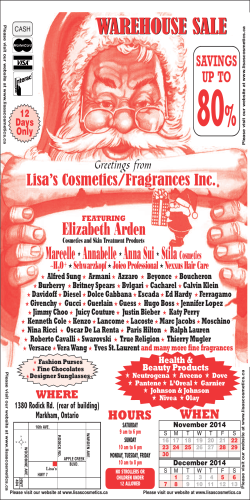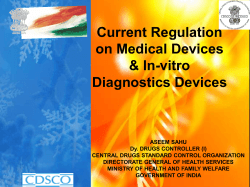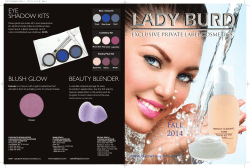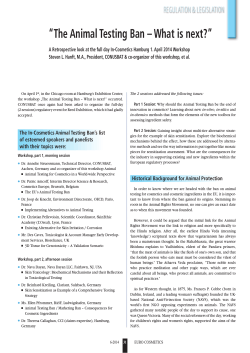
Dr. Gerd Mildau of the CVUA and Birgit PRODUCTION
PRODUCTION
LEGISLATION
The new regulations
put under the
microscope
The new EU Cosmetics Regulation
photo: Style-photography.de,
Shutterstock.com
What is really changing?
What are the most significant changes
in the new EU Cosmetics Directive
1223/2009?
Dr. Gerd Mildau, responsible for cosmetics
within the chemical and
veterinary investigation office (CVUA) in Karlsruhe,
Germany: Firstly not everything in
the EU Cosmetics Regulation has
changed. For instance the definition of
cosmetics, the intended use and the
reasonably foreseeable use of the
product, and the requirement for the
product to be safe, remain unchanged.
An important point, however, is that
the safety assessment requirements
have been specified.
Really new is an EU-wide product
related registration procedure, the
so-called Notification, plus a regulation
on common criteria for claims, and a
traceability procedure for products on
the market.
Birgit Huber, deputy
head of the IKW (German
Cosmetic, Toiletry, Perfumery and Detergent
Association) in Frankfurt,
Germany: In addition there is an
introduction of a notification on undesirable effects in cosmetics. Serious
undesirable effects must in future be
notified to the competent authorities.
This refers to such cases which after intended and reasonably foreseeable
use a consumer needs, for example, to
spend some time in hospital. Such
cases are of course extremely rare.
The Cosmetics Regulation also lays
down regulations for nanomaterials.
This makes cosmetics the first consumer products for which this category
of ingredients is explicitly regulated.
24
COSSMA 5 I 2013
Oxidative eyelash colorants
can continue to be used by
referring to the forthcoming
new regulations
What new points will the manufacturer
of cosmetics have to note when adopting the major requirements?
Huber: There are already a number
The substance lists in the annexes have
not yet been revised. Is there a concrete
plan set up to do this?
Mildau: Unfortunately the first draft
of different requirements which occupy
the manufacturers at the same time.
Firstly the safety assessments have to
be adopted progressively, but also the
products have to be declared to the
CPNP Notification Database at the
European Commission, which is complex.
Mildau: And with regard to the
reporting obligation of undesirable
effects: as far as I know German manufacturers have already taken this
problem on board in their own organisations to comply with their due diligence. In addition to this, however,
there is a new requirement for serious
cases. Here the European legislators
are attempting to create a cosmetovigilance system. With such a system it
should be recognised at an early stage
which substances may have a potentially negative effect on human health.
However, such a system can only
work if in serious cases it is clearly
identified that a cosmetic product was
really the trigger to the problem.
Huber: To know all of the relevant
facts can be very time-consuming. And
if there is no clear result it must not
be declared in order to avoid a data
cemetery.
1223/09 issued in January 2010 contained a few mistakes in the substance
related annexes, in particular in some
language versions. At the time it was
not, however, planned by the European
legislators to issue debugged annexes.
The first step was to issue the legal
text. These annexes represent the status at the end of 2007, the time when
the text was put forward to the European Parliament.
Part of the substance lists has since
then been updated or an amending
regulation should be published quite
soon. All of the amendments to the
Cosmetics Regulation after 2009 are
included. However the errors in the
appendices before 2009 must be corrected.
The working group, consisting of experts from member states, from the
European cosmetics industry and the
Commission, does not have much time
left. On July 11th 2013 the full EU Cosmetics Regulation comes into force,
including the annexes. Thus by this
date everything should be corrected.
Until that date the current EU Cosmetics Directive remains in force, with its
annexes. However this Regulation
must be referred to from July 11th
photo: Katalinks, Shutterstock.com
Dr. Gerd Mildau of the CVUA and Birgit
Huber of the IKW explain, in an interview
with COSSMA editor Angelika Meiss, what
is really new in the Cosmetics Directive,
which are the biggest challenges for the
manufacturer, and what can be expected
with the updating of the substance list and
the definition of nanomaterials.
Downloads
Additional information at
www.health-and-beauty.com/
qr00119
or you can just scan the QR code!
Your access codes for May:
User name: cossma5
Password: active
islative amendment. Even if this text
has not been published by July 11th
2013 producers will have the possibility to continue their sales by pointing
to the forthcoming regulation.
In the legislation it is
planned that the Annex IV which refers
currently to colorants (for the skin or
for products themselves) will also be
expanded to hair colorants. For this
purpose the precursors of oxidative
hair colorants are defined in the new
legislation as hair colorants. Firstly the
extensive risk assessment for hair colorant substances must be completed,
and for which there is an ambitious
programme from the EU Commission
and the industry. The industry has
committed itself to submit the data
confirming the safety of the hair colorants used to the EU‘s Commission
scientific committee.
Although a definition of
nanomaterials is included in the cosmetics legislation this definition does
leave a few unanswered questions.
There is also a horizontal definition
from the Commission relating to all
products concerned. Because there are
so far no official explanations with regard to horizontal recommendations
the European cosmetics industry has
created its own guidelines for interpretation.
Meanwhile the SCCS has already
evaluated the majority of the hair colorants used. As soon as all of the substances have been evaluated the positive list will be expanded and then
only the substances appearing on the
list will be permitted for use in hair
colorants products.
The regulations covering
nanomaterials are also new, as the implementation provisions of CMR substances. A “CMR substance” is classified in the regulations on hazardous
materials as carcinogenic, mutagenic
or toxic for reproduction. According to
the Regulation even substances classified as CMR 1A or 1B may be used in
cosmetics preparations in exceptional
cases, i.e. strict requirements are to
be met.
There should be in general according to the interpretation of the EU
Commission a dynamic reference to
the chemicals legislation of forbidden
CMR substances. In Annexes III to VI
of the Cosmetics Regulation only substances with a known CMR history will
be included. These will be only substances evaluated by the SCCS and approved via the comitology procedure
(this is the Standing Committee procedure in line with article 32) with restrictions such as percentage limits, or
warnings, and with a requirement for a
regular evaluation.
CMR substances not approved by
the SCCS will no longer appear in the
negative list of Annex II. Thus companies, and in particular the safety assessors, must have the chemicals legis lation permanently in mind.
should the outstanding corrections
not be published in time.
Substance related deviations are sometimes related to
changes in the definitions. For this
purpose a preamble to annexes II to
VI has been created. With regard to
hair care products it is, for example,
that eyelashes, as per the new definition, do not fall within the scope of
hair care.
Because hydrogen peroxide is, however, not specifically approved for use
in eyelash products, as from July 11th
2013 the whole oxidative eyelash colorants product group would no longer
be permitted.
Based on the collaboration of various interested parties the SCCS has
relatively short term issued a positive
evaluation of the main ingredients
used in eyelash colorant products. The
Commission has even presented a leg-
b[]_ibWj_ed PRODUCTION
Finally all substances classified as
nanomaterials must be notified separately since January 11th 2013 unless
they are in the annexes of the regulation subject to authorisation or they
will have been specifically authorized.
Such authorisations do not yet exist
but for the most commonly-used substances, such as titanium dioxide and
zinc oxide, approval is expected by
July 11th 2013.
Until an official definition is published we recommend companies to
use the guidelines of the European
cosmetics industry as a guide. Within
the notification full toxicological data
on the nanomaterial must be submitted in order to confirm the safety of the
substance. There is a special procedure for this within the CPNP process.
Another new point is the
marking of nanomaterials from July
11th, 2013, within INCI. Here the name
of the affected substance will be expanded with the suffix “nano” in parentheses. Within the product information
file a manufacturer must document
which nanoparticles are used. Analysis
of nanoparticles in the final product is
another big challenge. Whether it can
be achieved will be known when nanomaterials are precisely and officially
defined.
Wy{
_}{z{
cw{}
fwyw}}
VIP of the Month
© Copyright 2025



















